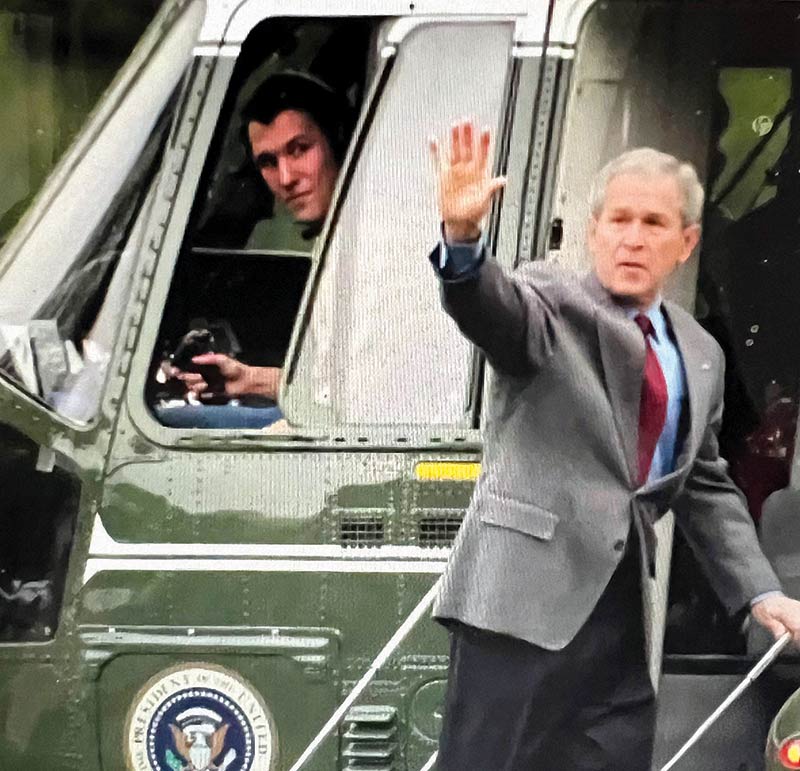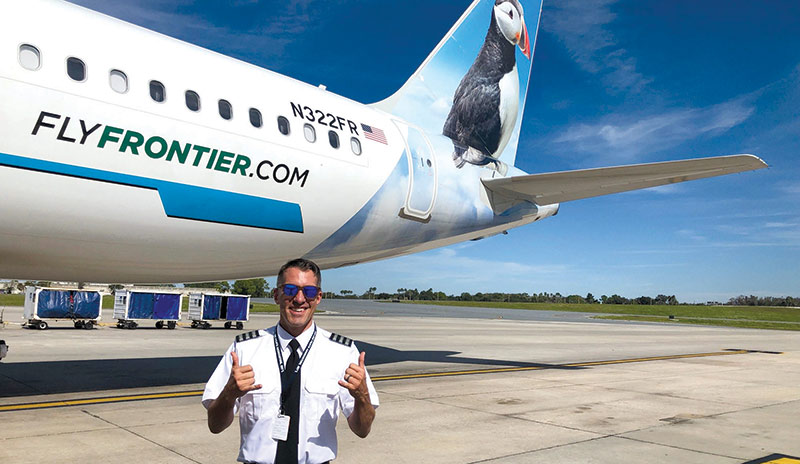Former Marine Recalls Days as White House Helicopter Pilot
By John Perkinson, Senior Staff Writer

During his tenure as a U.S. Marine Corp helicopter pilot, F/O John James (Frontier) transported President George W. Bush.
ALPA pilots often swap stories about notable passengers they’ve transported, including professional athletes, actors, and musicians. But F/O John James (Frontier) routinely flew heads of state during his tenure as a U.S. Marine Corps helicopter pilot. Assigned to Marine Helicopter Squadron One (HMX-1) for portions of the George W. Bush and Barack Obama U.S. presidential administrations, James was one of approximately 80 pilots providing airlift for the White House and its guests.
Call sign “Marine One,” the helicopters of the HMX-1 squadron have routinely transported presidents, vice presidents, senior cabinet members, and foreign dignitaries since the late 1950s. The standard run is between the White House South Lawn and nearby Andrews Air Force Base, where the president can access Air Force One, the military jet assigned for longer journeys.
“Anytime the president goes somewhere, he’s never for want of a helicopter,” said James, who remarked that he was required to travel to various destinations around the world to provide helicopter transport. In these scenarios, a Marine One helicopter would be transferred via military aircraft (along with a limousine known as “the beast”) to wherever the president needed local mobility.
James was once assigned to deliver state officials of the G-7—the intergovernmental political forum consisting of representatives from Canada, France, Germany, Italy, Japan, the UK, and the United States—while President Bush was visiting Japan.
The A320 first officer noted that Bush Senior Advisor and Deputy Chief of Staff Carl Rove was a regular passenger as was U.S. National Security Advisor Condoleezza Rice. On a particular trip, James transported her from Camp David, the presidential retreat in Frederick County, Md., to the White House.
On another occasion, James had an amusing exchange with Rahm Emanuel, chief of staff to President Obama, who advised the Marine pilot that some soldiers were milling around prior to the president’s arrival. While James had no jurisdiction over the soldiers, he communicated Emanuel’s displeasure and they soon conducted themselves with the proper decorum.
Marine One flights are coordinated by the “Whiteside” branch of the squadron, the executive flight detachment of the White House Military Office. Officially assigned to Quantico, Va., Whiteside operates from an adjunct facility at Joint Base Anacostia-Bolling in Washington, D.C.
During this special assignment, James flew the Boeing Vertol CH-46E Sea Knight, a medium-lift tandem-rotor transport helicopter. He also piloted the Sikorsky VH-3D Sea King and the Sikorsky VH-60N White Hawk. Needing to be qualified for all three aircraft at the same time “can give you some serious aircraft dyslexia,” he quipped.

James in front of a Frontier Airbus A320.
Comparing whirlybirds to fixed-wing aircraft, James observed, “There are no CAT III autoland controls and the helicopters had limited automation. Much of the flight was stick and rudder.” He added, “Helicopters are more difficult to fly precisely in IFR [instrument flight rules] conditions; in my experience, they’re more vertigo-inducing.”
Not surprisingly, these challenges made for some interesting scenarios and tough decision-making. Having to tell the White House that weather conditions prohibit safe travel requires both confidence and fortitude.
During his 23 years with the Marines, James had a host of experiences before retiring as a lieutenant colonel and becoming a pilot for Frontier nearly two years ago. “Unlike other branches of the service, the Marines highly value the generalist over the specialist,” he commented, adding, “I got everything I signed up for.”
Opportunities included a graduate-level education as well as serving as commanding officer of a training squadron, the staff officer and plan analyst for Manpower and Reserve Affairs, a helicopter pilot for three combat tours in Iraq, and a host of other demanding responsibilities.
Along with flight duties in the Marine One unit, James was also a White House liaison officer, acting as the lead planner for helicopter transportation for the president. In this capacity, he coordinated President Obama’s attendance at the 65th anniversary of the World War II D-Day invasion of Normandy in France.
While the time James flew for Marine One constitutes only a small portion of his military service, it clearly had a lasting impression. “It was a great experience. Flying Marine One was like having a front-row seat to history,” he said—a history that he, undeniably, is a part of.

